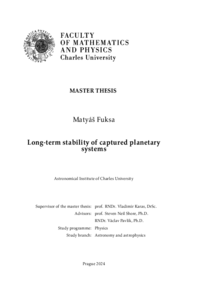Dlouhodobá stabilita zachycených planetárních systémů
Dlouhodobá stabilita zachycených planetárních systémů
diploma thesis (DEFENDED)

View/
Permanent link
http://hdl.handle.net/20.500.11956/192817Identifiers
Study Information System: 236416
Collections
- Kvalifikační práce [11899]
Author
Advisor
Consultant
Pavlík, Václav
Shore, Steven Neil
Referee
Haas, Jaroslav
Faculty / Institute
Faculty of Mathematics and Physics
Discipline
Astronomy and Astrophysics
Department
Astronomical Institute of Charles University
Date of defense
5. 9. 2024
Publisher
Univerzita Karlova, Matematicko-fyzikální fakultaLanguage
English
Grade
Very good
Keywords (Czech)
metody: numerické|planety a satelity: dynamický vývoj a stabilita|hvězdy: černé díry|neutronové hvězdy|pulzary: obecnéKeywords (English)
methods: numerical|planets and satellites: dynamical evolution and st|stars: black holes|neutron stars|pulsars: generalOd objevu prvnı ́ch exoplanet kolem pulsaru PSR 1257+12 a pozde ̌ji ko- lem PSR 1829−10 a PSR B1620−26 nebyl pu ̊vod planet jasny ́, pr ̌ic ̌emz ̌ bylo navrz ̌eno ne ̌kolik sce ́na ́r ̌u ̊. Tato pra ́ce si klade za cı ́l prozkoumat dlouhodo- bou stabilitu planeta ́rnı ́ch syste ́mu ̊ zachyceny ́ch v sce ́na ́r ̌i blı ́zke ́ho pru ̊letu neutronove ́ hve ̌zdy (NS) nebo c ̌erne ́ dı ́ry (BH) a zjistit, zda pulsarove ́ pla- nety mohou by ́t takove ́hoto dynamicke ́ho pu ̊vodu. Pomocı ́ simulacı ́ Slunec ̌nı ́ soustavy s NS (2 M⊙) nebo BH (10 M⊙) vetr ̌elcem za vyuz ̌itı ́ balı ́c ̌ku RE- BOUND v Pythonu a jeho numericke ́ho integra ́toru IAS15 byly sce ́na ́r ̌e inte- grova ́ny na c ̌asovy ́ch s ̌ka ́la ́ch milionu ̊ let (Myr) a miliard let (Gyr). Vy 'sledky ukazujı ́, z ̌e zachycene ́ syste ́my, ktere ́ jsou zpoc ̌a ́tku velmi chaoticke ́, majı ́ ten- denci vyhodit ve ̌ts ̌inu svy ́ch planet, aby dosa ́hly stabilnı ́ho stavu, pr ̌itom ob- vykle vytvor ̌ı ́dvou planeta ́rnı ́konfiguraci. Ne ̌ktere ́ syste ́my dosahujı 'stability ihned po zachycenı ́. Zby ́vajı ́cı ́ planety vs ̌ak obecne ̌ majı ́ vysoke ́ excentricity, na rozdı ́l od te ́me ̌r ̌ kruhovy ́ch drah nalezeny ́ch v syste ́mech PSR 1257+12 a PSR 1829−10. Pr ̌esto existujı ́ ne ̌ktere ́ pr ̌ı ́pady, jako je Jupiter v jedne ́ z prezentovany ́ch...
Since the discovery of the first exoplanets around the pulsar PSR 1257+12, and later around PSR 1829−10 and PSR B1620−26, the origins of these planets have been unclear, with several proposed scenarios. This thesis aims to investigate the long-term stability of planetary systems captured in a fly-by scenario by a neutron star (NS) or a black hole (BH), and to examine whether pulsar planets could have such a dynamical origin. Us- ing simulations of the Solar System with an intruding NS (2 M⊙) or BH (10 M⊙) utilizing the REBOUND Python package with its IAS15 numeri- cal integrator, the scenarios were integrated over million-year (Myr) and giga-year (Gyr) timescales. The results reveal that captured systems, ini- tially very chaotic, tend to eject most of their planets to reach a stable state, typically forming two-planet configurations. Some systems achieve stability directly after capture. However, the remaining planets generally have high eccentricities, in contrast with the nearly circular orbits found in the PSR 1257+12 and PSR 1829−10 systems. Yet, there are some cases, such as Jupiter in one of the presented simulations, which remains as a sole planet orbiting a NS with an eccentricity of 0.15, similar to the pulsar planet around PSR B1620−26. This suggests that the proposed dynami- cal capture...
